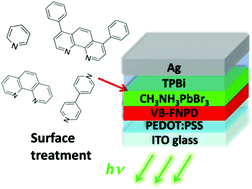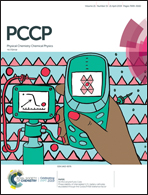Bidentate chelating ligands as effective passivating materials for perovskite light-emitting diodes†
Abstract
Herein, four pyridine-based chelating ligands, including 1,10-phenanthroline, 4,4′-bipyridine, 4,7-diphenyl-1,10-phenanthroline (Bphen) and pyridine, are used as surface treatment agents for improving the electronic properties of perovskite materials. The results of the steady-state photoluminescence (PL), time resolved PL and hole-only devices made of CH3NH3PbBr3 thin films suggest that the traps are effectively passivated after post-deposition surface treatment with bidentate chelating ligands, including 1,10-phenanthroline and 4,4′-bipyridine. Furthermore, the coordination capability of Bphen was suppressed which is probably due to its two additional phenyl groups, resulting in a steric hindrance effect. When compared with mono-dentate chelating pyridine, bidentate chelating ligands are more active in the current study. Finally, perovskite light-emitting diodes (PeLEDs) are fabricated and the devices exhibit a nearly doubled device efficiency after passivation with 1,10-phenanthroline. It is anticipated that the approach proposed here is a general method for improving the photonic properties of perovskite materials and the device performance of PeLEDs.



 Please wait while we load your content...
Please wait while we load your content...